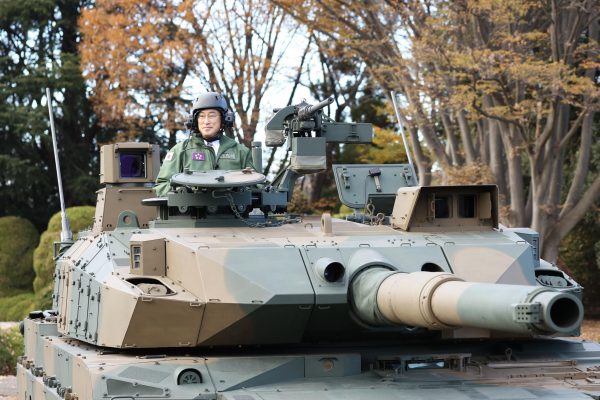This prompted Japan to take on a larger role in the US–Japan alliance and in safeguarding its own security. Ohira’s taskforce reinforced Japan’s commitment to the comprehensive security agenda by emphasising Japan’s proactive approach to non-military domains such as economic, food and energy security.
In 2022, Japan’s security strategy is once again groping towards a comprehensive approach but with greater emphasis on robust military capability, economic statecraft and technological innovation.
As the security environment surrounding Japan becomes more severe, maintaining a favourable balance of power has become an increasingly difficult task. Tokyo is currently facing challenges on three major strategic fronts. China — the biggest strategic challenge — boasts military capabilities which far outstrip those of Japan. The 2018 National Defense Program Guidelines highlighted that, as maintaining Japan’s maritime and air superiority becomes untenable, the Japan Self-Defense Forces (JSDF) will require major reform in terms of defence doctrine, capability and operations. This will necessitate significant increases in the defence budget as well as the adoption of innovative defence concepts.
The challenge for Japan’s defence reform derives from the need to prepare against two additional fronts: North Korea and Russia. North Korea’s continued development of nuclear and missile technologies signifies the growing risk of conflict escalation. Achieving the denuclearisation of North Korea while preparing for a possible crisis remain the top priorities of Japan’s strategy.
Russia’s invasion of Ukraine also presents new risks for Japan. The Japan–Russia peace treaty negotiations — which have remained unresolved since the end of the Second World War — were suspended indefinitely by Russia in April 2022. Russia will no longer hesitate to pressure Japan’s military and try to pursue deeper strategic alignment with China to challenge US military engagement in Asia.
Japan’s three strategic fronts — China, North Korea and Russia — all require different defence capability and posture requirements. If Tokyo invests in defence for each risk scenario separately, the cost will be enormous and the JSDF will eventually lose the opportunity to implement long-awaited China-focused reform. A comprehensive approach that places a greater emphasis on enhancing Japan’s economic security and the exploration of new domains such as cyber, space and emerging technologies is essential.
A robust increase in Japan’s defence budget must be the starting point for reform. Domestic public support for an increased defence budget was at a historic high during the Upper House election in July 2022. This came on the heels of the Japan–US Security Consultative Committee meetings between the ministers and secretaries for defence and foreign affairs, where Japan ‘reiterated its resolve to fundamentally reinforce its defence capabilities’. This commitment will see Japan look to upgrade its military capabilities to react to higher-end conflicts by ensuring interoperability with its allied forces.
More controversially, there has also been a push within the Japanese government to obtain counterstrike capabilities. With the introduction of hypersonic missiles, a technology possessed by both China and North Korea, Japan’s current missile defence capability is no longer sufficient. Tokyo has been exploring the possibility of acquiring counterstrike capabilities for the purpose of destroying enemy missile bases in foreign territories, but the scope of this is yet to be finalised.
On economic statecraft, Japan enacted its Economic Security Promotion Bill (ESPB) in May 2022, focusing on three major areas. The first area prioritises the need to protect sensitive technologies by placing more control on investments from and exports to specific foreign entities, and by ensuring that supply chains that are critical to sensitive high-tech sectors remain secure.
Additionally, the ESPB aims to ensure that Japan continues to work towards strategic indispensability. By increasing the funding for companies and institutions that conduct research and development (R&D) into key existing and new technologies, Tokyo can reinvigorate an area in which it has long lagged behind other countries. This will allow Japan to have a bigger security presence in the region and cease relying solely on military capability. And that should open up more opportunities for Japan to export defence equipment to friendly states, which will elevate Japan’s interoperability with other parts of the world.
Investing in technological development will also improve Japan’s economic security. Cutting-edge core technologies — such as robotics, artificial intelligence and quantum computing — will raise industrial competition within the private sector. At the same time, these dual use technologies can also be used in the development of military applications.
Japan’s R&D in defence technologies has not been terribly active compared with other countries. In the 2021–22 financial year, the Japanese Ministry of Defense requested a budget of 325.7 billion yen (US$2.5 billion) for R&D costs to strengthen defence technologies and their practical implementation. Increasing the defence budget will encourage long-term innovation, but there is still a long way to go to overcome public hesitation towards investing in military R&D.
The concerns faced by prime minister Ohira in the 1970s remain relevant today. Japan must double down on its efforts to achieve strategic autonomy and indispensability. Strengthening Japan’s military capabilities and investing in defence technology is a step in the right direction, but the pace leaves much to be desired.
Ken Jimbo is President of the Asia Pacific Initiative and Professor at the Faculty of Policy Management, Keio University.
Bryan Tan is Student Assistant at the Faculty of Policy Management, Keio University.
This article appears in the most recent edition of East Asia Forum Quarterly, ‘Japan’s strategic choices’, Vol 14, No 3.

